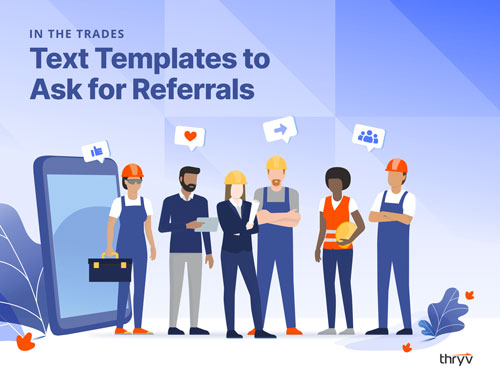What’s the key to customer loyalty for trades-oriented businesses?
We caught up with Cole Justice, product manager at Thryv, to pose some frequently asked questions about building customer loyalty for the trades, handling reviews, keeping track of customer data and more.

Free: Text Templates to Ask for Referrals
Save these six templates to ask your customers for referrals, along with helpful tips.
Save NowWhat tips and strategies can help customers stay loyal?
Building customer loyalty in the trades starts “before you’ve even met the customer,” Justice says.
The journey starts with how well you position your business to the customer. It’s about how your business comes across to them — from their initial Google search to that first phone call.
“To start building that, you’ll need to have a plan of attack,” he explains. Often it comes down to how much of an expert you appear to be; whether you look like the solution to their problem.
All of this feeds into the post-sale, or post-work, loyalty process. Using the example of a roofer, Justice says you could contact your client base when storms are forecasted, offering to check their roofs for any post-storm damage.
It’s personal touches like these that are crucial throughout the customer experience process.
What tools can tradespeople use to upsell additional services?
It really depends on what you do, Justice says.
First, it’s important not to upsell something a customer doesn’t need. That’s just bad business. But upselling is most effective when the proposed service is quick and simple — not just to carry out, but for the customer to decide on.
Justice gives us an example of a plumber, who is on a job and notices a broken toilet seat. The plumber could offer to fix that for a nominal charge.
Or if you’re in the heating, ventilation and air conditioning (HVAC) business, you could sell a purifier, humidifier or thermostat as part of any service call you make to a client’s home.
“But the biggest thing to remember is it needs to be quick, and it needs to have value for your customer,” Justice says.
What’s the best way to promote new services?
First, Justice says, any customer you try to build loyalty with has to know who you are. So don’t throw their info away! Keep track of who you do business with.
Having a customer relationship management (CRM) tool helps with this. It helps you store customer contact details after a purchase and contact them later down the line. That’s how you let them know about updates on services or products.
“Text is probably the best way … When you’re sending out a text message you’re gonna get probably two or three times as many people responding to that versus an email,” he explains.
And even if your existing customers aren’t interested in that new service or product, your business remains top-of-mind. Reminding them of your services helps them recommend you to someone else who does need them.
Why are reviews so important for people in the trades?
That’s your reputation on the line, Justice says.
Reviews often create that first impression — they might be the first thing someone sees of your business. Reviews do the same thing as signs or billboard advertising. They demonstrate your company is legitimate, that it’s worth doing business with and that you know what you’re doing.
“It shows you’re legit, you’re good, that you are who you say you are,” he explains.
What’s the best method to stay connected with customers?
These days, the best method is text messages; it’s great for one-on-one communications. But if you can get them to follow you on social media, that’s a really good way, too.
“It’s a bit tougher,” he says, but it does really help keep customers updated. If they follow you on social media, you can conveniently convey any promotions or new opportunities.
And what about timing? How often should you contact customers with new promotions? According to Justice, seasonal works best, which gives you good, ready-made reasons. For example, if you run an HVAC business, you want to contact people about getting their air conditioners in top shape before summer hits.
“You want everything to feel like you wrote it just for them. You don’t want to be sending a bunch of gas furnace info to someone who doesn’t have a gas furnace,” he says.
Again, a CRM helps with this. It keeps those kinds of details connected to each client’s record so you can use them for promotions like this.
“And it makes it so much faster,” Justice says.
What’s the most efficient way to keep track of invoices and payments?
Naturally, Justice recommends getting do-it-all business software, like Thryv.
“We’re past the point of stacks of paper,” he says. “You have to have your estimates going out, you have to have invoices going out — bonus points if you can also get your payments through that.
“But it’s gotta be software [doing that]. If not, you’re living in the past.”
How can I reward my clients’ loyalty?
You can get creative with this!
Justice thinks maintenance packages are nice. For example, you can run a promotion that if a customer books a free inspection, they get 10% off any needed services. You can even create niche lists of customers who share similar attributes (think geography or type of home), then send special deals just to them instead of a wider audience.
Or what about a free upgrade or install? Small things like that go a long way to building customer loyalty. And adding a personal touch helps reinforce that loyalty even further.
It’s hard being available to customers while on a job. Can that be easier?
If possible, hire someone to be available to take calls while you’re on jobs.
But the next-best solution is sending text messages while you’re on the job, Justice says. You’ll be able to respond to incoming messages more readily.
Even better is having a centralized inbox that pulls in any client message no matter which communication channel they use. That ensures you’ll never miss a message, regardless of whether it was sent online or through social media.
And even better than that? Offer online bookings. If you have “available slots” on your website, clients can book for themselves (or at least ask to book them), you can pick up the conversation when you’re back in the office.
“Even if you can’t answer right away,” Justice explains, “you still have them kind of locked-in for that. And you’re not overloading your time because you still have that (appointment) approval (process).”
Did we miss a burning question? Ask us! Let us know what you’d like to know more about, and we’ll post content or direct you to resources who can help. Visit Thryv’s YouTube channel for more chats with industry experts.

Text Templates to
Ask for Referrals
How to ask existing customers for referrals.








